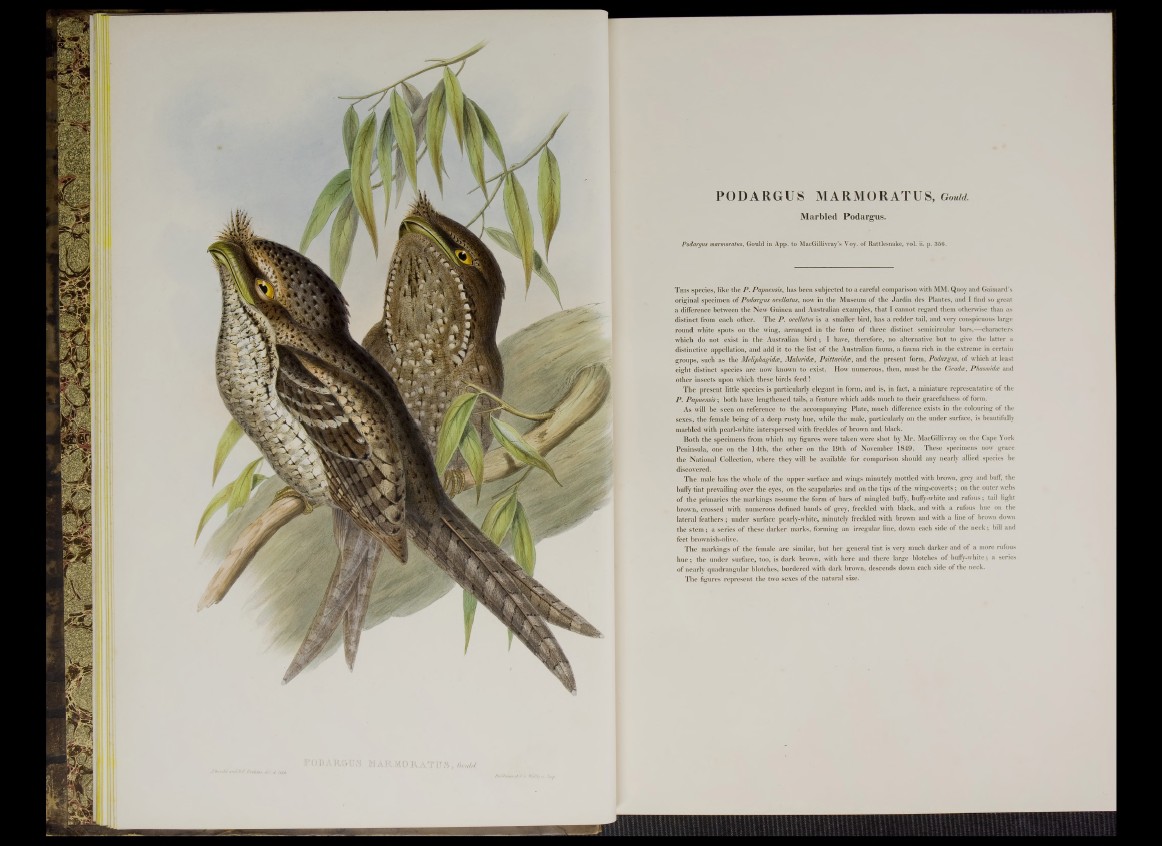
PODARGUS MARMORATUS , Gould.
Marbled Podargrts.
Podargus marmoratus, Gould in App. to MacGillivray’s Voy. of Rattlesnake, vol. ii. p. 356.
T h is species, like the P. Papuensis, has been subjected to a careful comparison with MM. Quoy and Gaimard’s
original specimen of Podargus ocellatus, now in the Museum of the Jardin des Plantes, and I find so great
a difference between the New Guinea and Australian examples, that I cannot regard them otherwise than as
distinct from each other. The P. ocellatus is a smaller bird, has a redder tail, and very conspicuous large
round white spots on the wing, arranged in the form of three distinct semicircular bars,— characters
which do not exist in the Australian bird; I have, therefore, no alternative but to give the latter a
distinctive appellation, and add it to the list of the Australian fauna, a fauna rich in the extreme in certain
groups, such as the Meliphagidee, Maluridce, Psittacidce, and the present form, Podargus, of which at least
eight distinct species are now known to exist. How numerous, then, must be the Cicadce, Phasmidce and
other insects upon which these birds feed!
The present little species is particularly elegant in form, and is, in fact, a miniature representative of the
P . Papuensis; both have lengthened tails, a feature which adds much to their gracefulness of form.
As will be seen on reference to the accompanying Plate, much difference exists in the colouring of the
sexes, the female being of a deep rusty hue, while the male, particularly on the under surface, is beautifully
marbled with pearl-white interspersed with freckles of brown and black.
Both the specimens from which my figures were taken were shot by Mr. MacGillivray on the Cape York
Peninsula, one on the 14th, the other on the 19th of November 1849. These specimens now grace
the National Collection, where they will be available for comparison should any nearly allied species be
discovered.
Hie male has the whole of the upper surface and wings minutely mottled with brown, grey and buff, the
buffy tint prevailing over the eyes, on the scapularies and on the tips of the wing-coverts ; on the outer webs
of the primaries the markings assume the form of bars of mingled buffy, buffy-white and rufous; tail light
brown, crossed with numerous defined bands of grey, freckled with black, and with a rufous hue on the
lateral feathers; under surface pearly-white, minutely freckled with brown and with a line of brown down
the stem; a series of these darker marks, forming an irregular line, down each side of the neck; bill and
feet brownish-olive.
The markings of the female are similar, but her general tint is very much darker and of a more rufous
h u e ; the under surface, too, is dark brown, with here and there large blotches of buffy-white; a series
of nearly quadrangular blotches, bordered with dark brown, descends down each side of the neck.
The figures represent the two sexes of the natural size.